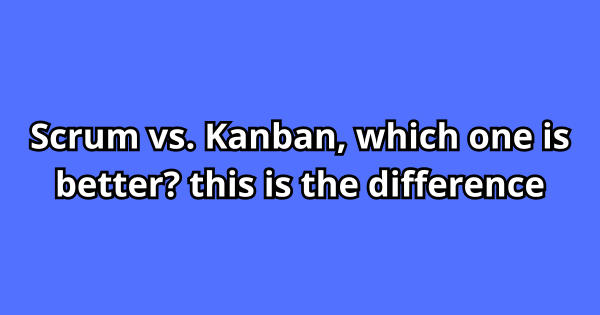Scrum vs. Kanban, which one is better? this is the difference
In today’s fast-paced, dynamic business environment, organizations are constantly striving for agility and responsiveness. Agile methodologies have emerged as a powerful solution, enabling teams to break down complex projects into manageable chunks, adapt to changing requirements, and deliver value incrementally. Within the Agile umbrella, two prominent frameworks stand out: Scrum and Kanban. While both share the core Agile values, they differ in their approach, structure, and implementation. Understanding these differences is crucial for choosing the right methodology for your project and maximizing its effectiveness.
What is difference between Scrum and Kanban?
Scrum: A Structured Approach for Delivering Value in Sprints
Scrum is a structured, prescriptive framework that follows a fixed-length cycle called a sprint. This iterative approach typically involves sprints of 2-4 weeks, during which teams work on a predetermined set of tasks (known as the sprint backlog) and deliver a working product increment at the end.
Key Scrum Elements:
- Roles: Scrum teams are comprised of dedicated roles, each with distinct responsibilities. The Product Owner prioritizes the backlog and defines the product vision, while the Scrum Master facilitates the process and removes impediments. The Development Team is self-organizing and accountable for delivering the sprint backlog.
- Artifacts: Scrum utilizes specific artifacts to track progress and manage work. These include the product backlog, sprint backlog, increment, and burndown chart.
- Ceremonies: Scrum incorporates regular ceremonies to facilitate communication, collaboration, and reflection. These include sprint planning, daily stand-up meetings, sprint reviews, and retrospectives.
Benefits of Scrum:
- Focus on delivering working software: Scrum emphasizes delivering tangible results at the end of each sprint, providing stakeholders with early feedback and opportunities for course correction.
- Increased predictability: The fixed-length sprint cycle fosters transparency and predictability, allowing teams to estimate effort and plan work effectively.
- Improved team collaboration: Scrum ceremonies promote regular communication and collaboration, leading to better alignment, ownership, and decision-making.
- Enhanced responsiveness to change: While changes are typically introduced at sprint boundaries, Scrum allows for adjustments within the sprint if critical issues arise.
Challenges of Scrum:
- Rigidity: The fixed-length sprint cycle can be inflexible and may not adapt well to highly dynamic environments.
- Overhead: Scrum ceremonies and artifacts require time and effort to implement and maintain.
- Team dependence: Scrum’s success hinges on a dedicated, experienced team with strong self-organizing capabilities.
Kanban: Continuous Flow for Optimizing Work Delivery
Kanban, in contrast to Scrum’s fixed-cycle approach, promotes a continuous flow of work. It uses a visual board to represent the various stages of work, allowing teams to visualize their workflow and optimize it for efficiency.
Key Kanban Elements:
- Board: The Kanban board serves as the central hub, depicting the workflow stages (e.g., To Do, In Progress, Done). Work items are represented by cards and move across the board as they progress.
- WIP Limits: Kanban emphasizes limiting work in progress (WIP) to prevent overloading the team and ensure smooth flow.
- Pull System: New work is pulled into the workflow only when capacity allows, ensuring focus and preventing multitasking.
- Metrics: Kanban relies on metrics like lead time, cycle time, and throughput to identify bottlenecks and improve flow efficiency.
Benefits of Kanban:
- Flexibility and adaptability: Kanban readily adapts to changing requirements and priorities, making it ideal for dynamic environments.
- Continuous improvement: Kanban’s focus on flow optimization encourages a culture of continuous improvement and experimentation.
- Reduced overhead: Kanban is lightweight and requires minimal overhead compared to Scrum ceremonies and artifacts.
- Visual representation: The Kanban board provides a clear, real-time overview of work progress, enhancing transparency and collaboration.
Challenges of Kanban:
- Lack of structure: Kanban’s flexibility can sometimes lead to a lack of focus and discipline, requiring strong team self-organization.
- Metrics dependence: Effective Kanban implementation relies heavily on tracking and analyzing metrics, which can be cumbersome for some teams.
- Limited visibility into future work: Kanban’s focus on the immediate workflow may provide less visibility into future commitments.
Finding the Right Fit:
Choosing between Scrum and Kanban depends on several factors, including:
- Project size and complexity: Scrum is better suited for complex projects with well-defined deliverables, while Kanban shines with smaller, less complex projects or ongoing work with continuous flow.
- Team experience and skills: Scrum requires a dedicated team with Agile experience, while Kanban can be adapted by teams with varying skillsets.
- Project deadlines and budget: Scrum’s sprint cycles provide predictability for deadlines, while Kanban allows for more flexibility.






